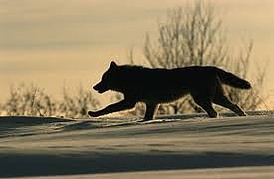
MYTHS ABOUT WOLVES THAT SHOULD NOT BE BELIEVED
Myth: Gray wolves are a threat to the livestock industry
The truth is, wolf depredations on livestock still accounts for less than 0.1% of all livestock losses in the Northern Rockies, which includes Montana, Wyoming, and Idaho. Nearly all cattle, 99.9%, die from causes other than wolves. It’s simply a myth to believe that ranchers have much to worry about.
Myth: Gray wolves aren’t native to the United States
Gray wolves inhabited much of Colorado long before the first settlers ever stepped foot on this land. For thousands of years, gray wolves helped to bring balance to Colorado’s ecosystem, allowing the life around them to flourish.
Myth: Gray wolves are dangerous to humans
You’re more likely to be struck by lightning or crushed by a vending machine than be attacked by a gray wolf. Gray wolves are extremely wary of humans. They are shy and retiring around people and will avoid them at all costs. In fact, there have only been two fatal wolf attacks in North America over the last century. With that, it’s safe to say that wolves historically have not represented a threat to human safety.
Myth: Gray wolves kill for sport
Nope, not true. Wild carnivores do not kill for fun; they kill to survive, which typically is very hard for gray wolves. It’s worth remembering that only humans kill for fun.
Myth: Gray wolves aren’t anything like humans
Gray wolves and humans have a lot in common. Much like the human family, gray wolves are pack animals. Wolves rely on their pack for support in the same ways we rely on our own families. Beyond their pack mentality, wolves can feel a broad spectrum of emotions from joy and happiness to sadness and despair. Killing one member of a pack can leave their whole family mourning their loss.
Myth: We don’t have any room for gray wolves in America
United States has public lands and bigger prey population for gray wolves than most anywhere else in the world. There is no doubt that Western States like Montana, Wyoming, Idaho, Colorado and many more, can not only accommodate gray wolves, but we can allow them to peacefully coexist with hunters and ranchers.
Myth: Gray wolves don’t need our help
Thousands of gray wolves used to roam and thrive in the wilderness, but today that number is zero. Although gray wolves pose very little risk to humans or livestock, they are the most hunted predator in US history. It is up to us to change how we see the vastly misunderstood gray wolf and give them the chance to come home.
WOLVES ARE LARGELY MISUNDERSTOOD DUE TO GREED, FEAR AND HATE THAT HAS BEEN PASSED DOWN FROM GENERATIONS.
WHAT WE ALL CAN DO TO SAVE THESE MYSTICAL AND MAJESTIC WILD ANIMALS IS:
* SPEAK UP FOR THERE SURVIVAL THROUGH EDCUATING OTHERS.
*WRITE YOUR LOCAL, STATE AND FEDERAL REPRESENTATIVES TO PROTECT WOLVES.
*SUPPORT REPUTABLE WOLF ORGANIZATIONS THAT ARE LOBBYING FOR WILDLIFE PROTECTION AND ARE IN THE FIELDS DOING WHAT IS NEEDED TO HELP WOLVES SURVIVE IN THE WILD WHERE THEY ARE NEEDED AND MEANT TO BE.
